Black Bottom was a predominantly black neighborhood in Detroit, Michigan. The term has sometimes been used to apply to the entire neighborhood including Paradise Valley, but many consider the two neighborhoods to be separate. Together, Black Bottom and Paradise Valley were bounded by Brush Street to the west, the Grand Trunk railroad tracks to the east, south to the Detroit River, and bisected by Gratiot Avenue. The area north of Gratiot Avenue to Grand Boulevard was defined as Paradise Valley.

Campus Martius Park is a re-established park in Downtown Detroit, Michigan. After the Great Fire of 1805, Campus Martius was the focal point of Judge Augustus Woodward's plans to rebuild the city. It was named for the principal square in Marietta, Ohio, the first capital of the Northwest Territory.

The J. L. Hudson Company was an upscale retail department store chain based in Detroit, Michigan. Hudson's flagship store, on Woodward Avenue in Downtown Detroit, was the tallest department store in the world in 1961, and, at one time, claimed to be the second-largest department store, after Macy's, in the United States, by square footage.

The Grand Circus Park Historic District contains the 5-acre (2.0 ha) Grand Circus Park in Downtown Detroit, Michigan that connects the theatre district with its financial district. It is bisected by Woodward Avenue, four blocks north of Campus Martius Park, and is roughly bounded by Clifford, John R. and Adams Streets. The district was listed on the National Register of Historic Places in 1983. The building at 25 West Elizabeth Street was added to the district in 2000, and additional structures located within the district, but built between 1932 and 1960, were approved for inclusion in 2012.
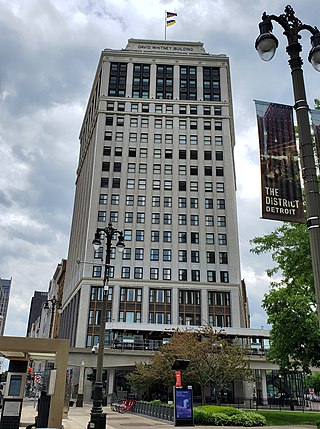
The David Whitney Building is a historic class-A skyscraper located at 1 Park Avenue, on the northern edge of Downtown Detroit, Michigan, within the Grand Circus Park Historic District. The building stands on a wedge-shaped site at the junction of Park Avenue, Woodward Avenue, and Washington Boulevard. Construction on the 19-floor structure began in 1914.

The Brush Park Historic District is a neighborhood located in Detroit, Michigan. It is bounded by Mack Avenue on the north, Woodward Avenue on the west, Beaubien Street on the east, and the Fisher Freeway on the south. The Woodward East Historic District, a smaller historic district completely encompassed by the larger Brush Park neighborhood, is located on Alfred, Edmund, and Watson Streets, from Brush Street to John R. Street, and is recognized by the National Register of Historic Places.
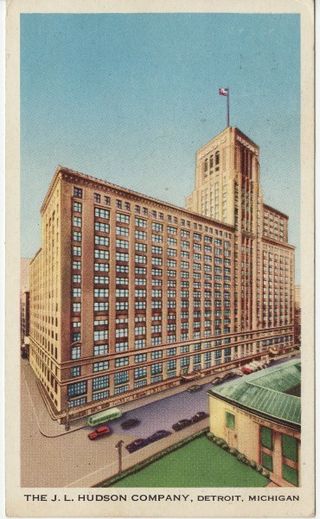
The J. L. Hudson Building ("Hudson's") was a department store located at 1206 Woodward Avenue in downtown Detroit, Michigan. It was constructed beginning in 1911, with additions throughout the years, before being "completed" in 1946, and named after the company's founder, Joseph Lowthian Hudson. Hudson's first building on the site opened in 1891 but was demolished in 1923 for a new structure. It was the flagship store for the Hudson's chain. The building was demolished in a controlled demolition on October 24, 1998, and at the time it was the tallest building ever imploded.

Crowley Milner and Company, generally referred to as Crowley's, was a department store chain founded in Detroit, Michigan, in 1909. After several years of financial difficulties, the company ceased operation in 1999 and its assets were sold.
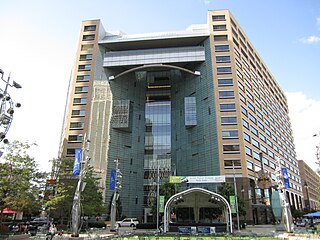
One Campus Martius is a building located in downtown Detroit, Michigan. It began construction in 2000 and was finished in 2003. It has seventeen floors in total, fifteen above-ground, and two below-ground, and has 1,088,000 square feet (100,000 m2) of office space. The high-rise was built as an office building with a restaurant, retail units, space for Compuware and a fitness center, as well as an atrium. The building now has Rocket Mortgage, Microsoft, Meridian Health, Plante Moran and Compuware as its major tenants.

Downtown Detroit is the central business district and a residential area of the city of Detroit, Michigan, United States. Locally, downtown tends to refer to the 1.4 square mile region bordered by M-10 to the west, Interstate 75 to the north, I-375 to the east, and the Detroit River to the south. Although, it may also refer to the Greater Downtown area, a 7.2 square mile region that includes surrounding neighborhoods such as Midtown, Corktown, Rivertown, and Woodbridge.

The Detroit Public Library is the second largest library system in the U.S. state of Michigan by volumes held and the 12th-largest public library system in the United States. It is composed of the Main Library on Woodward Avenue, which houses the library's administration offices, and 23 branch locations across the city. The Main Library is part of Detroit's Cultural Center Historic District listed in the National Register of Historic Places adjacent to Wayne State University campus and across from the Detroit Institute of Arts.
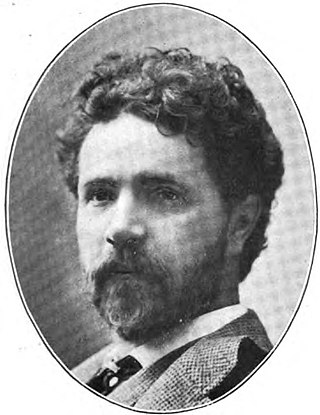
Donaldson and Meier was an architectural firm based in Detroit, Michigan. Founded in 1880 by John M. Donaldson (1854–1941) and Henry J. Meier (1858–1917), the firm produced a large and varied number of commissions in Detroit and southeastern Michigan. Donaldson, the principal designer of the partnership from a design point of view, was born in Stirling, Scotland and immigrated to Detroit at a young age. He returned to Europe where he studied at the Art Academy in Munich, Germany, and at the École des Beaux-Arts in Paris, France.
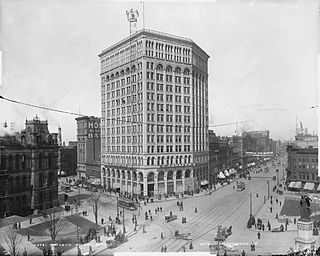
The Majestic Building was a high-rise building located at 1001 Woodward Avenue in Downtown Detroit, Michigan. The building was constructed in 1896 for the Mabley and Company department store chain and was the city's second skyscraper, following the completion of the Hammond Building. It contained 14 stories and stood at 68 m (223 ft) in height. This building was designed in the Beaux-Arts style by Daniel H. Burnham & Company, and faced with terra cotta. The final construction cost of the building was $1,000,000. This was Detroit's tallest building, from its completion in 1896 until 1909, when it was overtaken by the Ford Building. Unfortunately, C. R. Mabley died before the building's completion and new owners used it solely as an office block. It was purportedly renamed the Majestic building to conform with the letter "M" carved in numerous places in its façade.

The New Amsterdam Historic District is a historic district located in Detroit, Michigan. Buildings in this district are on or near three sequential east-west streets on the two blocks between Woodward Avenue and Second Avenue. It was listed on the National Register of Historic Places in 2001.

The Lower Woodward Avenue Historic District, also known as Merchant's Row, is a mixed-use retail, commercial, and residential district in downtown Detroit, Michigan, located between Campus Martius Park and Grand Circus Park Historic District at 1201 through 1449 Woodward Avenue and 1400 through 1456 Woodward Avenue. The district was listed on the National Register of Historic Places in 1999.
Tel-Twelve Mall is a shopping mall located in Southfield, Michigan, a suburb of Detroit, Michigan, United States. Developed as an enclosed mall in 1968, it was demolished and rebuilt in 2001 as a power center composed of big box tenants. Its anchor stores include Best Buy, DSW, Lowe's, Meijer, Michaels, Office Depot and PetSmart. The complex is owned and managed by Ramco-Gershenson Properties Trust, the same company that developed it.
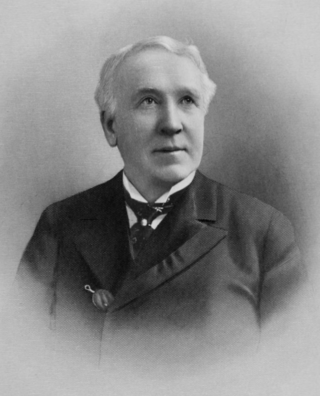
Cyrenius Adelbert Newcomb Sr. (1837–1915) co-founded Michigan's first department store, Newcomb-Endicott, which became one of the largest mercantile firms in the Midwest prior to World War I. He was also a leader in reform and philanthropic work. He was also a member of the Detroit Athletic Club and one of the donors who created the Detroit Institute of Arts.
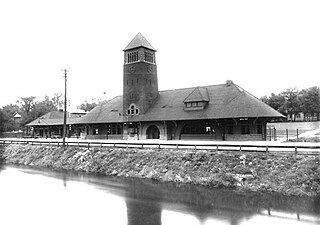
Rogers and MacFarlane was an architectural firm based in Detroit, Michigan, founded in 1885 by James S. Rogers and Walter MacFarlane. The firm produced commissions in Detroit and southern Michigan from 1885 until 1912.

The New Center Commercial Historic District is a commercial historic district located on Woodward Avenue between Baltimore Street and Grand Boulevard in Detroit, Michigan. It was listed on the National Register of Historic Places in 2016.

Hudson's Detroit is an under-construction mixed-use development located in Downtown Detroit, Michigan, United States. Located on the former site of J.L Hudson's Flagship Store, it is expected to be the second tallest building in Detroit as well as Michigan, at 208.7 meters (685 ft) and to be completed in 2024.





















